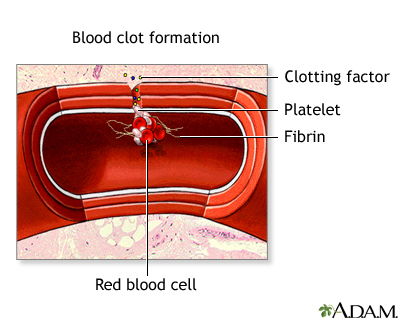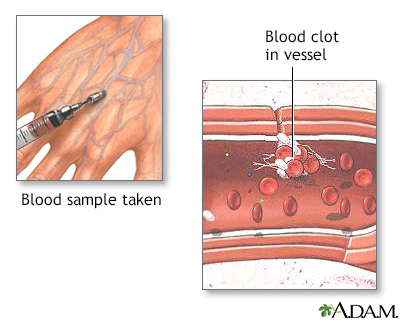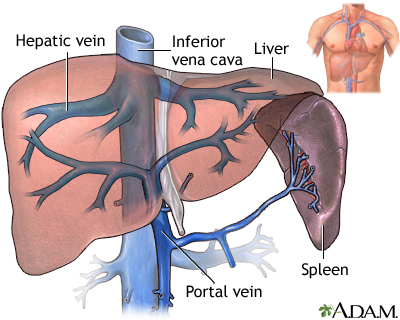Hepatic vein obstruction (Budd-Chiari)
Definition
Hepatic vein obstruction is a blockage of the hepatic vein, which carries blood away from the liver.
Alternative Names
Budd-Chiari syndrome; Hepatic veno-occlusive disease
Causes
Hepatic vein obstruction prevents blood from flowing out of the liver and back to the heart. This blockage can cause liver damage. Obstruction of this vein can be caused by a tumor or growth pressing on the vessel, or by a clot in the vessel (hepatic vein thrombosis).
Most often, it is caused by conditions that make blood clots more likely to form, including:
- Abnormal growth of cells in the bone marrow (myeloproliferative disorders)
- Cancers
- Chronic inflammatory or autoimmune diseases
- Infections
- Inherited (hereditary) or acquired problems with blood clotting
- Oral contraceptives
- Pregnancy
Hepatic vein blockage is the most common cause of Budd-Chiari syndrome.
Symptoms
Symptoms include:
- Abdominal swelling or stretching due to fluid in the abdomen
- Pain in the right upper abdomen
- Vomiting blood
- Yellowing of the skin (jaundice)
Exams and Tests
One of the signs is swelling of the abdomen from fluid buildup (ascites). The liver is often swollen and tender.
Tests include:
- Doppler ultrasound of the liver veins
- Liver function tests
- Ultrasound of the liver
Treatment
Treatment varies, depending on the cause of the blockage.
Your health care provider may recommend the following medicines:
- Blood thinners (anticoagulants)
- Clot-busting drugs (thrombolytic treatment)
- Medicines to treat the liver disease, including ascites
Surgery may be recommended. This may involve:
- Angioplasty and stent placement
- Transjugular intrahepatic portosystemic shunt (TIPS)
- Venous shunt surgery
- Liver transplant
Possible Complications
Hepatic vein obstruction can get worse and lead to cirrhosis and liver failure. This can be life threatening.
When to Contact a Medical Professional
Contact your provider if:
- You have symptoms of hepatic vein obstruction
- You are being treated for this condition and you develop new symptoms
Gallery





References
Kahi CJ. Vascular diseases of the gastrointestinal tract. In: Goldman L, Schafer AI, eds. Goldman-Cecil Medicine. 26th ed. Philadelphia, PA: Elsevier; 2020:chap 134.
Nery FG, Valla DC. Vascular diseases of the liver. In: Feldman M, Friedman LS, Brandt LJ, eds. Sleisenger and Fordtran's Gastrointestinal and Liver Disease. 11th ed. Philadelphia, PA: Elsevier; 2021:chap 85.
